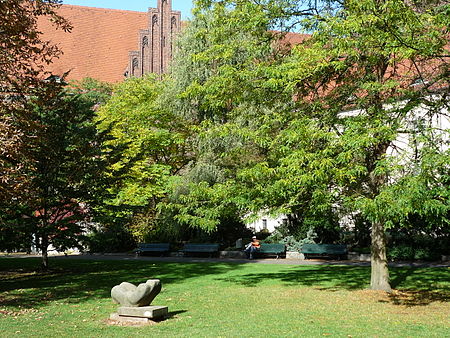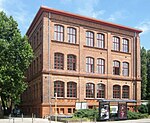Köllnischer Park

Köllnischer Park is a public park located near the River Spree in Mitte, Berlin. It is named after Cölln, one of the two cities which came together to form Berlin; the park location was originally just outside it. Approximately 1 hectare (2.5 acres) in area, the park came into existence in the 18th and 19th centuries on the site of fortifications. It was redesigned as a public park in 1869–73 and was further modified in the 20th century with the addition of first a bear enclosure, the Bärenzwinger, and later a permanent exhibition of sculpture, the Lapidary. The park is a registered Berlin landmark.The park contains five buildings, the first of them being the Märkisches Museum, a complex of buildings. The complex was built between 1907 and 1907, and was designed by Ludwig Hoffmann. The second was the Bärenzwinger, next to the south entrance to the park. This was built between 1938 and 1939 on the site of a former sanitation depot, and was designed by Ludwig Hoffmann. The Bärenzwinger has contained up to five bears at once, however no longer contains any following the death of Schnute, Berlin's last official city bear in 2015. At the east end of the park there is the Landesversicherungsanstalt building, a large office building designed by Alfred Messel, to be the headquarters of the Landesversicherungsanstalt, an insurance company. The fourth building is the AOK building, a six-storey steel-framed office building built from purplish brick, on the south side of the park, opposite the Bärenzwinger. The final building is the Volksbadeanstalt, on the western side of the park. It was built in 1888 as a public bath.
Excerpt from the Wikipedia article Köllnischer Park (License: CC BY-SA 3.0, Authors, Images).Köllnischer Park
Am Köllnischen Park, Berlin Mitte
Geographical coordinates (GPS) Address Nearby Places Show on map
Geographical coordinates (GPS)
| Latitude | Longitude |
|---|---|
| N 52.513055555556 ° | E 13.414722222222 ° |
Address
Märkisches Museum (Stadtmuseum)
Am Köllnischen Park 5
10179 Berlin, Mitte
Germany
Open on Google Maps










